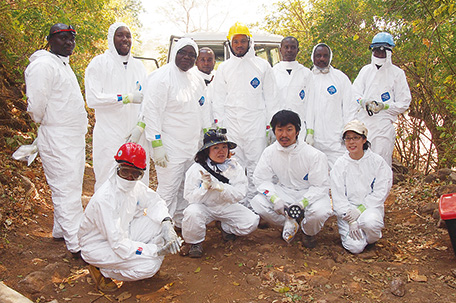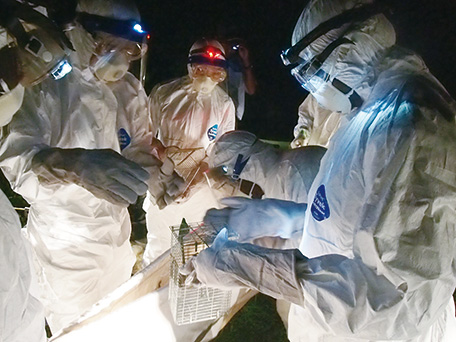Stories from the field 10
Aiming to Bring Viral Zoonoses under Control
– 30-year Relation of Cooperation between Hokkaido University and the University of Zambia’s School of Veterinary Medicine

Staff members wearing protective gear as they are about to depart on a survey together with Mr. Kajihara (front row, second from the right) and Ms. Mori (front row, second from the left). (Photo: Masahiro Kajihara)
The Ebola virus disease outbreak caused more than 10,000 deaths in West Africa in 2014. To this day the route of its transmission has not been clearly identified and treatment methods are still underdeveloped. Ebola, as well as SARS and avian influenza, are caused by viruses that infect both animals and humans. Furthermore, outbreaks of previously unknown viral zoonoses have been occurring in various places around the world, and setting up the countermeasures has become an important task.
Such viral zoonoses outbreaks have been confirmed in Zambia, located in the southern part of Africa, too. However, there is insufficient epidemiological information and diagnostic capabilities are also lacking to adopt appropriate countermeasures. The country has limited educational and research institutions as well.
Japan launched “the Project for Surveillance of Viral Zoonoses in Africa” in Zambia in June 2013. The goals of the project are to provide assistance for the development and improvement of diagnostic techniques for viral diseases, and to contribute to the strengthening of capacities for research, examination, and diagnosis of viral zoonoses.
Under this project, JICA experts, Masahiro Kajihara and his wife Akina Mori from Hokkaido University Research Center for Zoonosis Control have been engaged in various activities based at the University of Zambia’s School of Veterinary Medicine in the capital Lusaka. Hokkaido University and the University of Zambia’s School of Veterinary Medicine have maintained a long-lasting relationship. The University of Zambia’s School of Veterinary Medicine was established in 1985 with grant aid provided by Japan, and the faculty of Hokkaido University has spared no effort to provide technical cooperation. Since then, the two universities have continued to interact through the exchange of students and joint research for about 30 years.

Capturing bats in a cave in Zambia. (Photo: Masahiro Kajihara)
In research on viral zoonoses, it is crucial to grasp the habitat conditions of viruses and identify their route of entry into the human population. Under the Project for Surveillance of Viral Zoonoses in Africa, the JICA experts and researchers at the University of Zambia have been collecting the droppings of migratory birds, blood samples from bats, and ticks, and analyzing them jointly. Mr. Kajihara explains the significance of their work as follows:
“It is necessary to strengthen virology research capabilities in order to enable Zambian researchers to quickly identify an outbreak of, for instance, highly pathogenic avian influenza and adopt adequate countermeasures on their own.”
Through patient research, the project has so far succeeded in identifying three new virus strains and nine influenza virus strains.
Patients with suspected Ebola virus disease appeared in Zambia as well in August 2014, and the University of Zambia’s School of Veterinary Medicine was requested to diagnose them. Diagnosing the Ebola virus disease is a task that bears great responsibility. Besides the risk of infection to the researchers themselves, if a patient is diagnosed with Ebola, the information that Zambia is a country at risk of Ebola contamination will quickly spread all over the world. Fortunately, all 16 suspected cases of Ebola infection that have been examined so far were negative.
Providing assistance to enable Zambian researchers to independently make accurate diagnoses under such intense pressure is another goal of this project. In order to acquire a high level of diagnostic techniques, it is necessary to understand the importance of examinations and participate in them voluntarily. When diagnostic activities were first implemented, however, most Zambian researchers were reluctant to participate. Ms. Mori explains that in those early days she used to boost researchers’ self-confidence by telling them that no one else but them could do it. “People perform to the best of their ability when they are relied upon. The Zambian researchers also came to the realization that after the completion of the project, they would have to perform diagnoses on their own,” says Ms. Mori.
The Ebola virus outbreak, which for a while reached epidemic conditions, is now being brought to an end through the various efforts by the local and international community, but it is impossible to predict when another outbreak of Ebola or other infectious diseases will occur. According to Mr. Kajihara, “Accurate and swift diagnosis is crucial in order to minimize the damage inflicted by infectious diseases. I hope that researchers will not become overconfident in their own skills and will spare no effort to minimize the risk of failure.”
Mr. Kajihara also points out the necessity to vigorously implement research in order to improve diagnostic techniques. There are only a few outstanding Zambian researchers who have acquired doctoral degrees abroad and have various research ideas. However, in reality, the University of Zambia’s School of Veterinary Medicine lacked the necessary budget for these researchers to realize their ideas. At the beginning of the project, many Zambian researchers tended to be reserved about expressing their research ideas, so Mr. Kajihara made efforts to convey that they were the leaders of the project and should conduct research that they considered to be meaningful. As a result of these encouraging words, the number of researchers who took advantage of the project to concentrate on their own research themes increased.
Mr. Kajihara and Ms. Mori have been engaged in this project, which has been jointly implemented with researchers from the University of Zambia, out of a desire to support the devoted efforts of these researchers, with the ultimate objective of bringing viral zoonoses under control.
<< Previous Page Next Page >>
Main Text | Statistics and Reference Materials | Stories from the field | Master Techniques, From Japan to the World | ODA Topics
